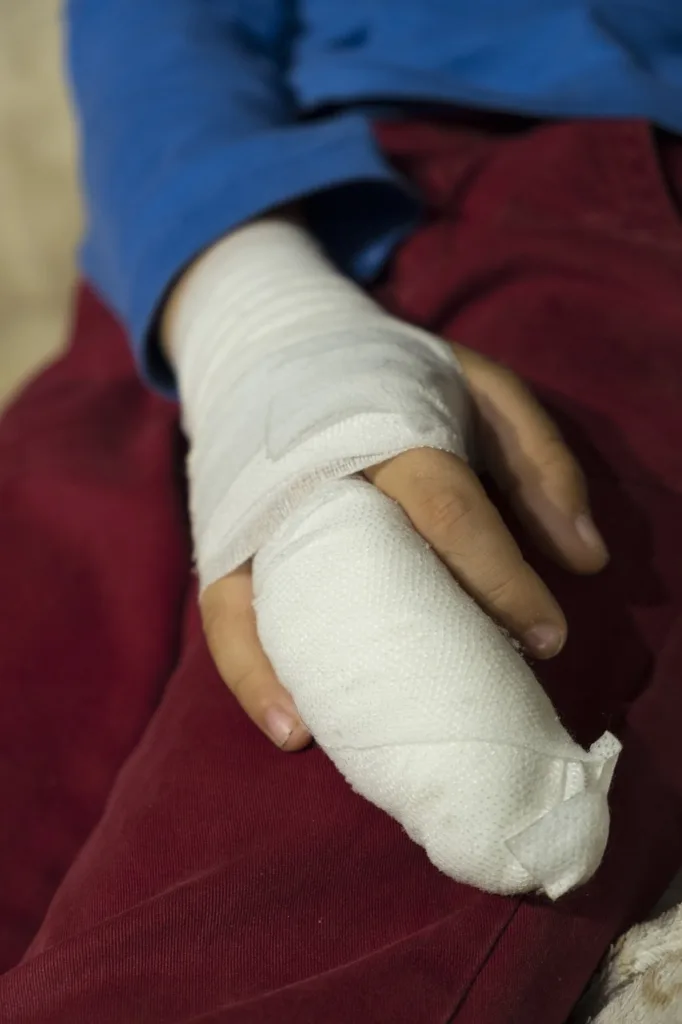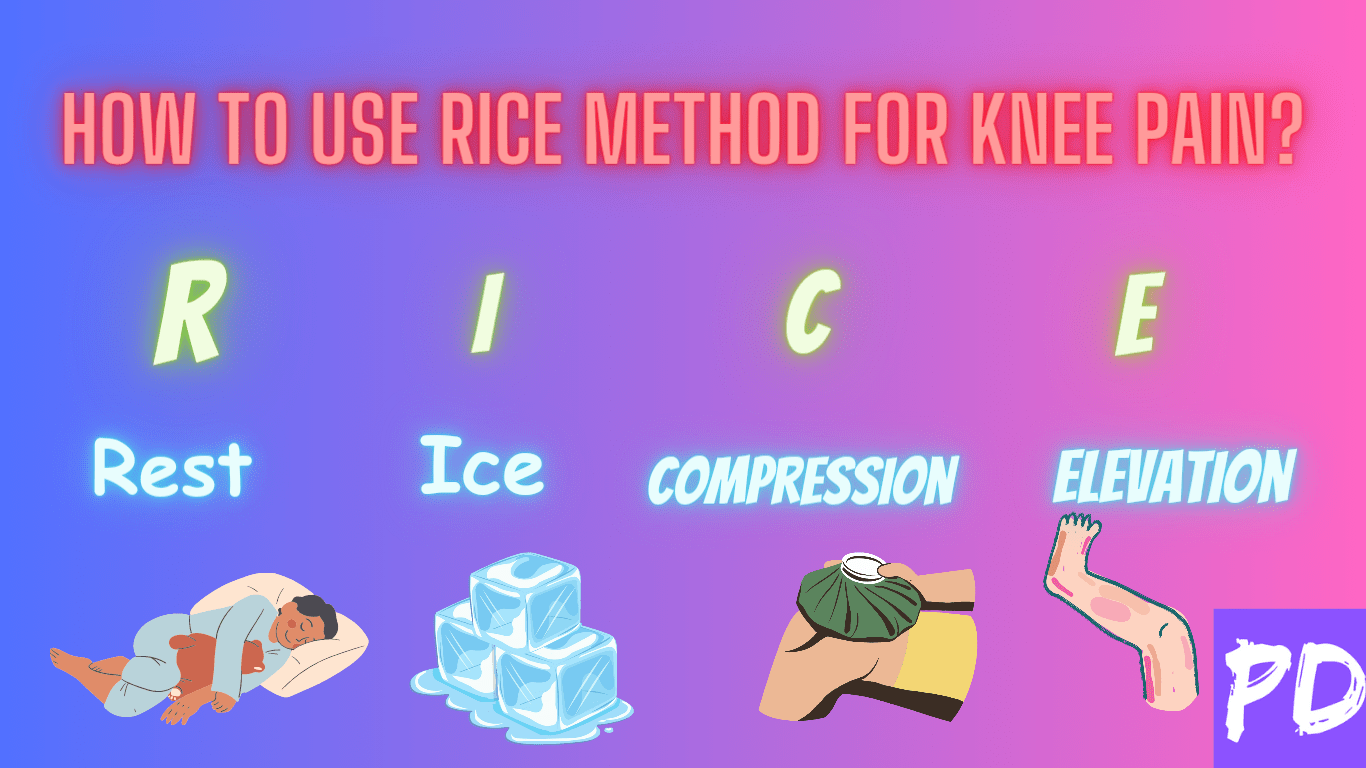Knee pain is a common complaint that affects millions of people worldwide. Finding effective ways to manage knee pain is crucial for maintaining an active lifestyle and healthy lifestyle.
One of the most widely recommended methods for treating acute knee pain is RICE Method.
In this blog post, we will explore what the RICE method entails and how you can use it to alleviate knee pain and promote healing.
What is RICE Method ?
The acronym RICE stands for Rest, Ice, Compression, and Elevation.
It is an effective way to manage injuries, including knee pain.
The RICE method plays a role in reducing pain, inflammation, and promoting healing.
- Rest: It’s important to rest the knee to allow it to heal. Try to minimize weight-bearing activities during the initial stages of injury and avoid activities that make the injury worse.
- Ice: Applying ice to the injured knee can help. Blood flow to the injured area is reduced by ice. Apply an ice pack wrapped in a thin towel to the knee several times a day.
- Compression: Applying compression to the knee using an elastic bandage or brace helps reduce swelling and provides stability to the joint. Ensure that the compression is firm but not tight, as it should not restrict blood flow.
- Elevation: The injured knee can be raised above the heart level to encourage fluid drainage. During rest periods, prop your leg up on a pillow or cushion.
How do you use the RICE method?
The RICE method is an effective way to manage knee pain and promote healing. Here’s a step-by-step guide on how to use the RICE method:
Rest

When you experience knee pain, it’s important to give your knee a rest. Avoid activities that worsen the pain or put excessive strain on your knee joint. Take a break from intense workouts or sports that may aggravate the injury. By allowing your knee to rest, you give it time to heal.
Ice

Applying ice to the affected knee helps reduce pain and swelling. Take an ice pack or a bag of frozen peas wrapped in a thin towel. Apply the ice pack to the painful area for about 15-20 minutes at a time. Repeat this several times a day, especially during the initial stages of the injury. The cold temperature constricts blood vessels, reducing inflammation and providing relief.
Compression

Compression is an important aspect of the RICE method. Use an elastic bandage or a compression sleeve to apply gentle pressure to your knee. Start wrapping the bandage at the bottom of your leg and work your way up, ensuring even pressure throughout. Compression helps reduce swelling, provides support to the injured tissues, and improves blood circulation in the area. Be careful not to wrap the bandage too tightly, as it should allow proper circulation.
Elevation

Elevating your knee helps reduce swelling by encouraging fluid drainage. Whenever possible, prop your leg up on a pillow or cushion so that your knee is elevated above the level of your heart. This position allows gravity to assist in the removal of excess fluid from the injured area. Keep your leg elevated during rest periods to maximize its effectiveness.
How you can effectively use RICE Method to manage knee pain
Now that you understand the components of the RICE method, let’s delve into how you can effectively use it to manage knee pain.
- Assess the Severity: Determine the severity of your knee pain. If the pain is intense or accompanied by instability, it is essential to consult a healthcare professional for a proper diagnosis and treatment plan.
- Immediate Response: If you’ve recently injured your knee, it’s crucial to initiate the RICE method as soon as possible. Rest the knee, apply ice to reduce swelling, and consider using compression and elevation techniques.
- Rest and Protection: Avoid activities that aggravate the pain and put excessive stress on your knee. Give your knee ample rest, especially during the acute phase of the injury. Consider using crutches or a knee brace to provide additional support and stability.
- Ice Application: Apply an ice pack to the affected knee for 15-20 minutes every 2-3 hours for the first 48-72 hours. Remember to wrap the ice pack in a cloth or towel to prevent direct skin contact, as it can cause ice burns.
- Compression Techniques: Use an elastic bandage or knee brace to apply compression to the injured knee. Start at the bottom of the leg and work your way up, ensuring even pressure throughout. Remove the compression bandage if you experience numbness, tingling, or increased pain.
- Elevation: Whenever possible, elevate your leg by propping it up on a pillow or cushion. Aim to keep your knee elevated above the level of your heart. This position helps reduce swelling and encourages fluid drainage
Additional Tips for Knee Pain Management
While the RICE method forms the foundation of knee pain management, incorporating these additional tips can further enhance your recovery:
- Pain Management: Over-the-counter nonsteroidal anti-inflammatory drugs (NSAIDs) can help alleviate pain and reduce inflammation. Consult with your healthcare provider before taking any medication.
- Gentle Exercises: Once the acute phase has passed, gentle exercises and stretches can help improve knee strength and flexibility. Consider consulting a physical therapist for a personalized exercise plan.
- Heat Therapy: After the initial 48-72 hours of using the RICE method, you can switch to applying heat to your knee. Heat increases blood flow to the area, promoting healing and relaxation. Use a warm towel or a heating pad for 15-20 minutes, several times a day.
- Maintain a Healthy Weight: Excess body weight places additional stress on your knees. Maintaining a healthy weight reduces the load on your knee joints and can help alleviate pain.
How long should I RICE my knee?
The duration of RICE (Rest, Ice, Compression, Elevation) for your knee can vary depending on the severity of the injury or pain.
However, as a general guideline, it is recommended to apply RICE for about 48 to 72 hours after the onset of the injury or when the pain first occurs.
During this initial period, follow the RICE method consistently and frequently to maximize its effectiveness in reducing pain and swelling.
After the initial 48 to 72 hours, you can gradually transition to other forms of treatment or consult a healthcare professional for further guidance based on your specific situation.
Conclusion
In conclusion, the RICE method is a simple and effective approach for managing knee pain. By following the principles of rest, ice, compression, and elevation, individuals can alleviate discomfort, reduce swelling, and promote healing. The RICE method can be used as an initial treatment for minor knee injuries, such as sprains or strains, and can also be beneficial in managing chronic knee conditions. However, it is important to consult with a healthcare professional for a proper diagnosis and personalized treatment plan.
The information provided in this article is for educational purposes only and should not be considered as medical advice. The RICE method is generally safe for managing mild knee pain; however, it is crucial to consult with a qualified healthcare professional for an accurate diagnosis and personalized treatment plan.


